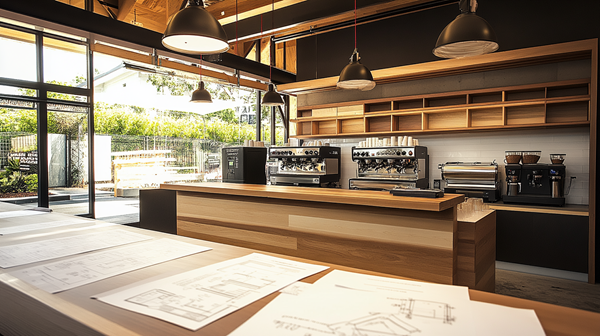Key takeaways: How to finance a restaurant or café fit-out in Australia
- Restaurant fit-out costs can range from $2,500 to $4,000+ per sqm, depending on concept, location, and kitchen infrastructure.
- 80% of new hospitality businesses in Australia rely on external financing to complete their fit-out, according to IBISWorld 2023.
- Fit-out finance options include equipment finance, unsecured business loans, chattel mortgage, and specialised fit-out loans.
- Landlord contributions may cover up to 30% of your total fit-out costs, but vary by lease negotiation.
- Cash flow planning is critical—underestimate your cash buffer and you may struggle in the first 6 months.
Introduction: Turning your dream venue into a reality
Planning your restaurant or café fit-out is exciting, but it can also be financially daunting. From furniture and kitchen equipment to ventilation and compliance, costs add up fast. Whether you're opening a coffee shop, bakery, or full-service restaurant, having the right finance plan in place can make all the difference to your launch and long-term viability.
In this article, we break down the top ways to finance your hospitality fit-out in Australia, real-world costs, common mistakes, and how to improve your chances of securing the funds you need.
Understanding restaurant and café fit-out costs in Australia
Fit-out costs vary depending on your venue type, location, and size. Here’s what you can expect:
- Cafés and quick-service outlets: $2,000 – $3,000 per sqm
- Mid-range restaurants: $2,500 – $4,000 per sqm
- High-end dining or bars: $3,500 – $6,000+ per sqm
Fit-out finance options for hospitality businesses
There are several tailored finance options to help you fund your fit-out. The right one for your business depends on your credit profile, cash flow, and how quickly you need funds.
1. Equipment finance
- Use for commercial kitchen equipment, refrigeration, POS systems, etc.
- Equipment is used as collateral.
- Preserves working capital.
- Terms usually range from 2–5 years.
2. Unsecured business loan
- Fast approval (1–3 business days).
- Flexible use of funds.
- Typically requires 6–12 months of trading history.
- Higher interest rates than secured options.
3. Fit-out loan
- Specifically designed for renovations and shopfitting.
- Can cover builders, designers, and compliance costs.
- Can be secured or unsecured.
4. Chattel mortgage
- Used to buy and own fit-out assets upfront.
- Interest and depreciation may be tax-deductible.
- Fixed repayment terms.
Should you consider landlord contributions?
Negotiating a landlord contribution or fit-out incentive is common in commercial leases. In competitive locations, landlords may offer to cover part of your fit-out to attract a quality tenant.
Pros:
- Reduces your upfront costs.
- Helps preserve your capital for marketing and operations.
Cons:
- May come with higher rent or longer lease commitments.
- Could limit your design flexibility.
Typical contributions range from $200 to $600 per sqm, or 10–30% of your total fit-out, depending on location and landlord strategy.
Key tips for a smooth fit-out financing process
- Get quotes early: Builders, kitchen suppliers, designers.
- Create a fit-out budget: Include contingency (10–20%).
- Talk to a broker or finance specialist: They can match you with lenders that understand hospitality.
- Plan for cash flow: Have a 6-month runway to cover operations after opening.
- Don’t rely on just one funding source: Mix of loan, savings, and incentives is common.
FAQs: Financing your restaurant or café fit-out
Q: Can I get finance for a café fit-out if I’m a first-time operator?
A: Yes, but lenders may ask for a business plan, financial projections, and personal guarantees. Consider unsecured loans or landlord contributions.
Q: How long does it take to get fit-out finance?
A: Some lenders can approve unsecured loans or equipment finance in 24–72 hours, while larger or secured loans can take up to 2–4 weeks.
Q: Can I finance both my kitchen equipment and shop design in one loan?
A: Yes. Some fit-out loans and business loans allow you to bundle all elements into one facility.
Q: Is leasing equipment a better option than buying?
A: Leasing can lower upfront costs and improve cash flow, but you won't own the asset. Compare total costs over time.
Financing checklist: what lenders want to see
To increase your chances of approval and secure the best rate, make sure your finance application includes:
- Detailed business plan: Include concept, target market, location, and forecasted revenue
- Fit-out quotes: At least 1–2 detailed estimates from licensed shopfitters
- Lease agreement: Signed lease or Heads of Agreement showing your rental obligations
- Business financials: Profit/loss statements, BAS, or tax returns (if already trading)
- Director ID and credit score: Especially for unsecured finance or if applying as a sole trader
Bonus tip: Lenders love seeing pre-approval from council or DA submissions. It shows you're serious and compliant.
Common mistakes to avoid when financing your fit-out
Many first-time operators run into these avoidable errors:
1. Underestimating total project cost
Fit-outs often go over budget by 15–20%. Always include a contingency buffer when applying for finance.
2. Not separating equipment from structural works
Use different finance types. Fit-out finance for walls, plumbing, and design; equipment finance for cooktops and fridges.
3. Overcommitting to a short lease
Don’t invest $200K in a venue with a 2-year lease. Try to match your finance term to your lease length with an option to renew.
4. Assuming landlord contributions are guaranteed
Even if incentives are offered, get them in writing. Many are conditional on milestones.
5. Forgetting compliance and certification costs
Licensing, council approvals, health inspections, fire services—these add up fast and must be factored into your budget.
Conclusion: Set your business up for long-term success
Whether you choose to finance your café or restaurant fit-out through loans, landlord contributions, or a combination of both, planning ahead is key. Understand your full cost structure, explore your finance options, and don’t forget to factor in a cash buffer for your first few months of trading.
With the right strategy, you’ll be in a strong position to launch a standout venue that’s financially sustainable from day one.


